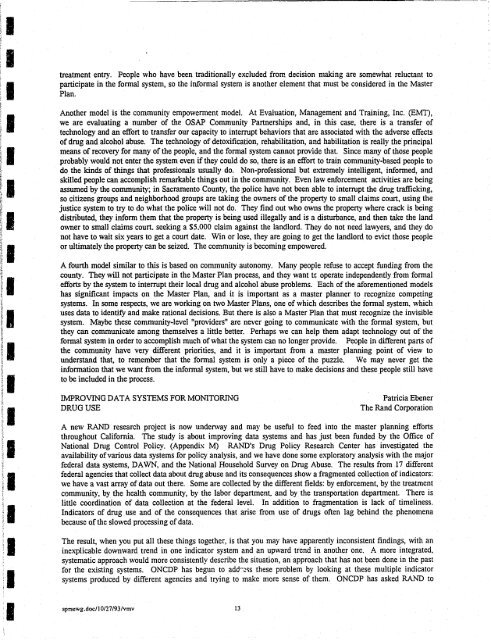1 - National Criminal Justice Reference Service
1 - National Criminal Justice Reference Service
1 - National Criminal Justice Reference Service
You also want an ePaper? Increase the reach of your titles
YUMPU automatically turns print PDFs into web optimized ePapers that Google loves.
I<br />
I<br />
I<br />
I<br />
treatment entry. People who have been traditionally excluded from decision making are somewhat reluctant to<br />
participate in the formal system, so the informal system is another element that must be considered in the Master<br />
Plan.<br />
Another model is the community empowerment model. At Evaluation, Management and Training, Inc. (EMT),<br />
we are evaluating a number of the OSAP Community Partnerships and, in this case, there is a transfer of<br />
technology and an effort to transfer our capacity to interrupt behaviors that are associated with the adverse effects<br />
of drug and alcohol abuse. The technology of detoxification, rehabilitation, and habilitation is really the principal<br />
means of recovery for many of the people, and the formal system cannot provide that. Since many of those people<br />
probably would not enter the system even if they could do so, there is an effort to train community-based people to<br />
do the kinds of things that professionals usually do. Non-professional but e~'tremely intelligent, informed, and<br />
skilled people can accomplish remarkable things out in the community. Even law enforcement activities are being<br />
assumed by the community; in Sacramento County, the police have not been able to interrupt the drug trafficking,<br />
so citizens groups and neighborhood groups are taking the owners of the property to small claims court, using the<br />
justice system to try to do what the police will not do. They find out who owns the property where crack is being<br />
distributed, they inform them that the property is being used illegally and is a disturbance, and then take the land<br />
owner to small claims court. seeking a $5.000 claim against the landlord. They do not need lawyers, and they do<br />
not have to wait six years to get a court date. Win or lose, they are going to get the landlord. to evict those people<br />
or ultimately the property can be seized. The community is becoming empowered.<br />
A fourth model similar to this is based on community autonomy. Many people refuse to accept funding from the<br />
county. They will not participate in the Master Plan process, and they want t~ operate independently from formal<br />
efforts by the system to interrupt their local drug and alcohol abuse problems. Each of the aforementioned models<br />
has significant impacts on the Master Plan, and it is important as a master planner to recognize competing<br />
systems. In some respects, we are working on two Master Plans, one of which describes the formal system. which<br />
uses data to identify and make rational decisions. But there is also a Master Plan that must recognize the invisible<br />
system. Maybe these community-level "providers" are never going to communicate with the formal system, but<br />
they can communicate among themselves a little better. Perhaps we can help them adapt technology out of the<br />
formal system in order to accomplish much of what the system can no longer provide. People in different parts of<br />
the community have very different priorities, and it is important from a master planning point of view to<br />
understand that, to remember that the formal system is only a piece of the puzzle. We may never get the<br />
information that we want from the informal system, but we still have to make decisions and these people still have<br />
to be included in the process.<br />
IMPROVING DATA SYSTEMS FOR MONITORING<br />
DRUG USE<br />
Patricia Ebener<br />
The Rand Corporation<br />
I<br />
I<br />
I<br />
.1<br />
,I<br />
I<br />
A new RAND research project is now underway and may be useful to feed into the master planning efforts<br />
throughout California. The study is about improving data systems and has just been funded by the Office of<br />
<strong>National</strong> Drug Control Policy. (Appendix M) RAND's Drug Policy Research Center has investigated the<br />
availability of various data systems for policy analysis, and we have done some exploratory analysis with the major<br />
federal data systems, DAWN, and the <strong>National</strong> Household Survey on Drug Abuse. The results from 17 different<br />
federal agencies that collect data about drug abuse and its consequences show a fragmented collection of indicators:<br />
we have a vast army of data out there. Some are collected by the different fields: by enforcement, by the treatment<br />
community, by the health community, by the labor department, and by the transportation department. There is<br />
little coordination of data collection at the federal level. In addition to fragmentation is lack of timeliness.<br />
Indicators of drug use and of the consequences that arise from use of drugs often lag behind the phenomena<br />
because of the slowed processing of data.<br />
The result, when you put all these things together, is that you may have apparently inconsistent findings, with an<br />
inexlJlicable downward trend in one indicator system and an upward trend in another one. A more integrated,<br />
systematic approach would more consistently describe the situation, an approach that has not been done in the past<br />
for the existing systems. ONCDP has begun to add~Cjs these problem by looking at these multiple indicator<br />
systems produced by different agencies and trying to make more sense of them. ONCDP has asked RAND to<br />
spr:;.ewg.doc/IO/27/93/vmv 13
















